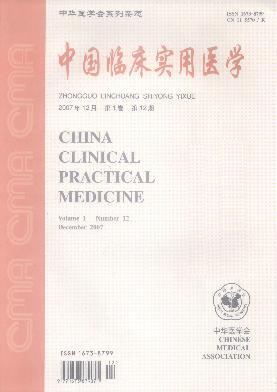Risk factors of hemorrhage transformation after ischemic stroke and its prediction model
引用次数: 0
Abstract
Objective To establish a prediction model by analyzing the related risk factors of hemorrhage transformation (HT) after ischemic stroke. Methods A retrospective study was performed on 327 cases of patients with ischemic stroke who were admitted from January 2015 to September 2016.The pathogenesis,clinical manifestation and general data of patients were retrospectively analyzed.The risk factors of HT were selected by logistic regression analysis and other methods,a new prediction model was established,and the evaluation boundary value of the ROC curve was obtained,which was greater than the evaluation boundary value was in HT high risk group. Results Atrial fibrillation ( OR=4.940,95%CI: 1.879~12.988,P<0.05 ),systolic blood pressure higher than 160 mmHg ( OR=2.762,95%CI: 1.175~6.494,P<0.05,1 mmHg=0.133 kPa ),massive cerebral infarction ( OR=3.796,95%CI: 1.495~9.635,P<0.05),NIHSS score more than 10 points ( OR=5.665,95%CI: 2.289~14.021,P<0.05),thrombolytic treatment ( OR=3.086,95%CI: 4.981~96.257,P<0.05) were independent risk factors for HT.Prediction model: Logit P=-3.588+ 1.579×X1+ 1.016×X2+ 1.334×X3+ 1.734×X4+ 3.086×X5.The AUC was 0.912 (95%CI: 0.873~0.950,P<0.001). When the boundary value was-2,the sensitivity was 88.33%,specificity is 82.02%. Conclusion Atrial fibrillation history,systolic blood pressure which is higher than 160 mmHg,massive cerebral infarction,NIHSS score is more than 10 point,and thrombolytic treatment are independent risk factors for HT.The patient will have a higher risk of HT,when the boundary value is greater than-2. Key words: Ischemic stroke; Hemorrhage transformation; Risk factor; Prediction model缺血性脑卒中后出血转化的危险因素及预测模型
目的通过分析缺血性脑卒中后出血转化(HT)的相关危险因素,建立预测模型。方法对2015年1月至2016年9月我院收治的327例缺血性脑卒中患者进行回顾性分析。回顾性分析患者的发病机制、临床表现及一般资料。通过logistic回归分析等方法选择HT的危险因素,建立新的预测模型,得到ROC曲线的评价边界值,HT高危组的评价边界值大于HT高危组的评价边界值。结果房颤(OR=4.940,95%CI: 1.879~12.988,P<0.05)、收缩压高于160 mmHg (OR=2.762,95%CI: 1.175~6.494,P<0.05,1 mmHg=0.133 kPa)、大面积脑梗死(OR=3.796,95%CI: 1.495~9.635,P<0.05)、NIHSS评分大于10分(OR=5.665,95%CI: 2.289~14.021,P<0.05)、溶栓治疗(OR=3.086,95%CI: 4.981~96.257,P<0.05)是HT的独立危险因素。预测模型:Logit P=-3.588+ 1.579×X1+ 1.016×X2+ 1.334×X3+ 1.734×X4+ 3.086×X5。AUC为0.912 (95%CI: 0.873~0.950,P<0.001)。当边界值为-2时,敏感性为88.33%,特异性为82.02%。结论房颤病史、收缩压高于160 mmHg、大面积脑梗死、NIHSS评分大于10分、溶栓治疗是HT的独立危险因素。当边界值大于2时,患者发生HT的风险较高。关键词:缺血性脑卒中;出血转化;风险因素;预测模型
本文章由计算机程序翻译,如有差异,请以英文原文为准。
求助全文
约1分钟内获得全文
求助全文

 求助内容:
求助内容: 应助结果提醒方式:
应助结果提醒方式:


